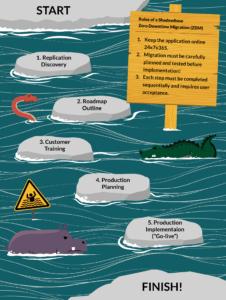The Connection, July/August 2023
By Paden R. Holenstein
The Connection, July/August 2023
By Paden R. Holenstein
 There are numerous approaches to migrations. One HPE NonStop user said, “We fall forward,” meaning, they migrate their application to the new system NO MATTER WHAT, even if there are issues.
There are numerous approaches to migrations. One HPE NonStop user said, “We fall forward,” meaning, they migrate their application to the new system NO MATTER WHAT, even if there are issues.
Risky approaches like this are bound to fail.
Would you “skip” across predator-infested waters at full speed? While no one in their right mind would do this in the physical world, the same concept applies during a migration in the digital world.
Many are simply unaware of what best practices look like or that a better approach exists. Successful migrations result from careful planning and partnership with the customer and the solution’s vendor, following best practices, and executing five iterative steps. This process ensures that:
A Zero Downtime Migration (ZDM) eliminates the risk that a problem will delay the migration, costing end users downtime and enterprises exorbitant sums of money, not to mention a public relations nightmare. HPE Shadowbase software gives stakeholders peace of mind knowing that they will not lose vital data, time, or money.
While some efforts can occur in parallel, in general, each “Stepping Stone” (Step) of the migration requires acceptance before moving onto the next step, especially implementation. We created this infographic to illustrate how to safely cross the “migration river” by eliminating the risks associated with migrations and following procedures that include best practices.
Warnings
When planning a migration, remember:
Generally, copying the configuration for the current solution, applying it to the new solution, and forcing the new solution into production will not work. Different replication products have different configuration settings; there is generally not a simple 1:1 mapping between them. This approach would likely yield in a failed migration and cause outages.
Migrations must be carefully planned and tested before implementation!
While there are many potential pitfalls along the way, if you follow the following three rules, you will have a successful Shadowbase ZDM:
The Five Stepping Stones
These Project Deployment Steps are based on industry-specific field research that we conducted with several different teams and experts who perform these migrations day in and day out. While it lists the most common Shadowbase deployment steps, it is not all-inclusive, meaning certain customer situations will demand a more customized response, longer timeframes, or additional verification procedures. Professional services are often required for training, to help resolve any issues, and to ensure that the solution successfully transitions from testing into production.
We greatly enjoyed putting this research together and hope these Stepping Stones enable you to cross the river and make it to the other side with confidence by performing a successful, risk-free migration! Would you like to see a more detailed version of this infographic? Contact your local HPE Shadowbase representative or contact us.
For more information:
HPE Shadowbase Zero Downtime Migration (ZDM) software provides continuous availability, eliminates planned downtime (no application services downtime during the migration), and removes business risk from application, database, and system migrations and upgrades.
Hewlett Packard Enterprise globally sells and supports Shadowbase solutions under the name HPE Shadowbase.